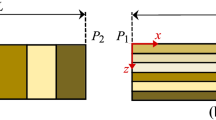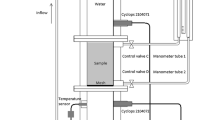Abstract
The flow of a particle fluid mixture through a heterogeneous permeable material is studied with a view to obtaining characteristic fingerprints for the structures that such flows may exhibit. This flow has a variable density and behaves as a compressible fluid, with the compressibility derived from the variations of the local field variables. Both pressure-sensitive or speed-fluctuation-dependent rheologies are studied in the steady state and a speed-fluctuation-dependent material is studied in a time-dependent analysis. The salient findings are that for a pressure-sensitive material structures normal to the mean flow direction are obtained. For the speed-fluctuation-dependent rheology, the pressure structures are normal to the mean flow, whereas the density structures are aligned with the flow (fingering).





Similar content being viewed by others
References
Bird RB, Stewart WE, Lightfoot EN (1960) Transport phenomena. Wiley, New York
Dagan G (1989) Flow and transport in porous formations. Springer, Berlin Heidelberg New York
Happel J, Brenner H (1986) Low Reynolds number hydrodynamics. Kluwer, Dordrecht
Jackson ED (1961) Primary texture and mineral associations in the ultramafic zone of the Stillwater complex, Montana. US Geological Survey Professional Paper 358
Koenders MA (1997) Evolution of spatially structured elastic materials using harmonic density function. Phys Rev E 56:5585–5593
Koenders MA (1998) Effects of microstructure and non-linearity in heterogeneous materials. J Phys D Appl Phys 31:1875–1862
Koenders MA, Kilchherr R (2002) Structures formation of slurries in heterogeneous porous media. J Phys D App Phys 35:1–8
Kröner E (1967) Elasticity theory of materials with long range cohesive forces. J Mech Phys Solids 15:319–329
Marsh BD (1989) Encyclopedia of solid Earth geophysics. Van Nostrand and Reinhold, New York, pp 676–688
McBirney AR (1984) Igneous petrology. Jones and Barlet, Sudbury, MA
McTigue D, Jenkins JT (1992) Advances in micromechanics of granular materials. Elsevier, Amsterdam, pp 381–390
Naslund HR, McBirney AR (1996) Mechanics of formation of igneous layering. Elsevier, New York, pp 1–44
Petford N, Koenders MA (1998) Self-organisation and fracture connectivity in rapidly heated continental crust. J Struct Geol 20(9/10):1425–1434
Saffman PG, Taylor GI (1958) The penetration of a fluid into a porous medium or Hele–Shaw cell containing a more viscous fluid. Proc R Soc A 245:312–329
Author information
Authors and Affiliations
Corresponding author
Appendix
Appendix
Mathematical analysis of time-dependent flow equations
The basic equation is Eq. (20) as shown below.
This equation contains both time-dependent and time-independent terms. The solution for p +(x,t), therefore, also includes time-dependent and time-independent parts. The latter are of most interest here. They are easily identified and the resulting equation for the explicitly time-dependent reads.
This equation is essentially linear and contains the averaged material properties and velocity only. It may be analysed by means of a spatial Fourier transform and a temporal Laplace transform. The latter transform is denoted by a ~ and the Laplace frequency is called s.
The Fourier transform with wave vector λ is denoted by a ^. Its definition and inverse are given here by Eqs. (10) and (11).
Equation (A2) in the Fourier domain takes the form
This algebraic equation is readily solved for \( \hat{\tilde{p}} \) to yield
The pressure pulse is introduced at t=0 and its form is such that it is localised and has a convenient mathematical form, in order to preserve as much analyticity as possible.
Doing the inverse Laplace transform leaves
where \( a = \lambda _{1} {\left( {B\bar{v} + 1} \right)}/B + \lambda ^{2}_{2} \bar{\rho }/{\left( {\lambda _{1} B} \right)} \).
The inverse Fourier transform is now carried out. It is convenient to work with positive integration variables only; straightforward algebra yields
The function \( \hat{p}{\left( {\lambda ,0} \right)} \) is specified. A convenient form is \( \hat{p}{\left( {\lambda ,0} \right)} = P_{0} e^{{ - \lambda \mu }} \). The parameter μ has the dimension of a length and indicates the spatial extent of the initial disturbance. This corresponds to a representation in the spatial domain of the form
The integration over λ2 in Eq. (A6) is scaled by introducing a change in variable λ2=λ10. Equation (A6) then takes the form
The integral over λ1 is elementary. The result is
where \( S_{{1,2}} = x_{1} \pm \theta x_{2} - \frac{{B\bar{v} + 1}} {B}t - \frac{{\bar{\rho }t}} {B}\theta ^{2} \).
Despite its apparent simple form, the integral over θ cannot be done analytically, except for t=0; it is easily done numerically however.
Rights and permissions
About this article
Cite this article
Kilchherr, R., Koenders, C. A flow mechanism for layering in a heterogeneous porous medium. Vis Geosci 9, 1–8 (2004). https://doi.org/10.1007/s10069-003-0014-x
Received:
Accepted:
Published:
Issue Date:
DOI: https://doi.org/10.1007/s10069-003-0014-x




